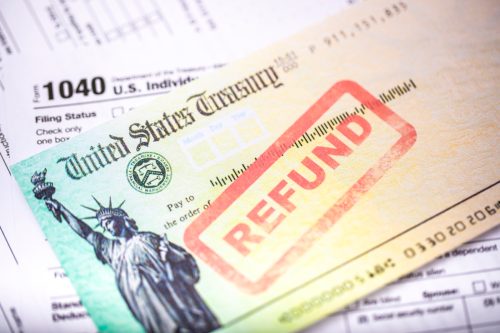IRS Has Issued 8 Million Refunds—Here’s How Much People Are Getting Back in 2023

Most of us dread doing our taxes every year, as it’s often a stressful and needlessly confusing process. But we can’t exactly skip this annual chore—for one thing, that’s illegal, and for another, many of us depend on the money we get back every tax season. In fact, a Credit Karma survey found that 30 percent of taxpayers say they’re relying on their tax refund this year just to make ends meet. But how much should we expect to receive in 2023? Less than a month since tax season started, the Internal Revenue Service (IRS) has already issued roughly 8 million refunds. Read on to find out how much taxpayers are getting back so far.
READ THIS NEXT: 3 IRS Deductions You Can’t Take This Year, Experts Warn.
The IRS is expecting to receive over 168 million tax returns in 2023.

You can go ahead and submit your 2022 tax return at any point, as the new filing season started on Jan. 23. Most taxpayers have until April 18 to file taxes this year before they’re considered late, but it appears that many Americans have already gotten theirs out of the way.
More than 168 million individual tax returns are expected to be filed in total this season, according to the IRS. But the agency just released its first weekly report for the 2023 filing statistics, revealing that millions of returns have already been submitted and processed. As of Feb. 3, nearly 19 million returns have been received, and out of those, the IRS has managed to process around 16.7 million.
Roughly 8 million refunds have already been issued.

Refunds have already started making their way back to taxpayers as well. As of Feb. 3, roughly 8 million refunds have been issued, according to the latest data. So far, the IRS has refunded a total of $15.7 billion—which is a substantial increase from the total amount refunded this same time last year. By this point in 2022, the agency had refunded a total of about $9.5 billion, though it had also only sent out about 4 million refunds.
But how much exactly are individual taxpayers really getting? According to the new report, the average refund amount for each return is $1,963 so far this year. Despite an increase in the overall total amount refunded in 2023, this is actually 10.8 percent lower than what taxpayers were receiving in 2022. The average refund amount for each return was $2,201 this same time last year.
RELATED: For more up-to-date information, sign up for our daily newsletter.
The agency is warning taxpayers to expect smaller refunds this year.

It shouldn’t come as a surprise that the average tax refund is lower than it was in 2022. After all, the IRS has already warned that this would likely be the case.
“Many taxpayers may find their refunds somewhat lower this year,” the agency said in a Jan. 23 press release. There are several “tax law changes” going into effect in 2023 to reset adjustments that were made in light of the pandemic, according to the IRS.
This includes the “elimination of the Advance Child Tax Credit and no Recovery Rebate Credit this year to claim pandemic-related stimulus payments,” the IRS said. Changes have also been made to the amount awarded for certain credits.
“Some tax credits return to 2019 levels. This means that affected taxpayers will likely receive a significantly smaller refund compared with the previous tax year,” the agency added.
For example, eligible recipients for the Child Tax Credit (CTC) will only get $2,000 per dependent, while they received $3,600 for each with their 2021 return. In terms of the Earned Income Tax Credit (EITC), eligible taxpayers with no children received roughly $1,500 in 2021, but will now get just $500. And the maximum Child and Dependent Care Credit will go back down to $2,100 instead of $8,000.
You should also prepare for a potential delay on your refund.

The IRS is not only warning taxpayers about lower refund amounts—the agency has also advised people against expecting to receive their refund in a specific amount of time.
“Although the IRS issues most refunds in less than 21 days, the IRS cautions taxpayers not to rely on receiving a 2022 federal tax refund by a certain date, especially when making major purchases or paying bills,” the agency said in a Dec. 6 press release.
According to the IRS, there are many different factors that could impact the timing of your refund. “Some returns may require additional review and may take longer to process if IRS systems detect a possible error, the return is missing information or there is suspected identity theft or fraud,” the agency explained.
Best Life offers the most up-to-date financial information from top experts and the latest news and research, but our content is not meant to be a substitute for professional guidance. When it comes to the money you’re spending, saving, or investing, always consult your financial advisor directly.